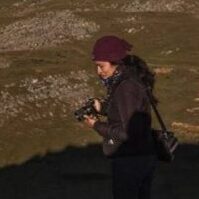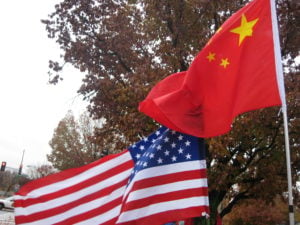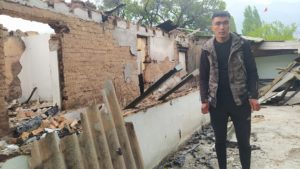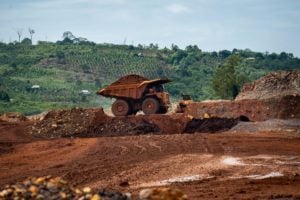The white paint covering the walls of the Mamani Flores family home has worn away. Mould and cracks spread across the cement that holds up this house in Chancay, a small city on the Peruvian coast, 80 kilometres north of Lima.

There has been a settlement here for generations, the Chancay were an ancient pre-Columbian civilisation who lived here before the Incas. The fishing industry grew in the middle of the last century, and over the years, tourism filled the space in the economy between artisanal fishing for local consumption and the production of fishmeal.
Today, the more than 60,000 citizens who reside here are divided over the construction of one of the most ambitious projects promoted by the Peruvian government: the mega-port of Chancay.
The cracked houses of Chancay
Since the movement of machinery began in the first months of 2020, the Mamani Flores family residence has suffered serious damage, including the rupture of a water pipe that flooded their entire house.
The Mamani’s live only 100 metres from a wall that separates them from the land occupied by Cosco Shipping Ports Chancay Peru, the consortium in charge of the project. Underneath this area there will be a 1.8 kilometre tunnel providing a road connection between the consortium’s logistics centre and the port.
The mega-port of Chancay — an estimated total investment of US$3 billion — aims to become a hub for trade between Asia and South America. The consortium’s shareholders are Chinese state-owned Cosco Shipping Ports Limited and Peru’s Volcan Compañía Minera S.A.. The latter has a history of committing environmental violations in the Andean regions of Junín and Pasco.
In 2016, Peruvian company Volcan, through its subsidiary Terminales Portuarios Chancay S.A., bought land for the mega-port of Chancay through an offshore company, as revealed in a report by investigative outlet Convoca. In January 2019, it signed an agreement in which the Chinese company became a 60% shareholder of the consortium and it was renamed Cosco Shipping Ports Chancay Peru.
It’s going to be a big investment, but how much are we going to lose? Maybe at some point we will have to leave
Throughout these changes accusations of damage to the houses continued. In March 2017, a group of neighbours complained to local media that a series of explosions and excavations carried out as part of the Environmental Impact Assessment (EIA) had caused cracks in their houses.
The National Environmental Certification Service for Sustainable Investments (Senace), the public body in charge of reviewing and approving the project’s environmental impact study, was aware of this situation. This is evidenced by various reports issued by the body since March 2019, accessed through a transparency request. One noted: “there is disagreement with the project due to the land affectations carried out”.
The consortium acknowledged, in documents linked to the modification of the EIA, that the effects of vibrations from its work ranged from “always perceptible” to “strongly perceptible” for people in the vicinity, confirming the accounts of the port’s neighbours.
Following the complaints the company paid for some minor repairs. These included replacing cracked windows, Diálogo Chino was told during a visit to more than a dozen homes in the areas where the Mamani’s live.
However, according to the owners, serious damage continues. and has yet to be addressed.
How much are we going to lose?
“The location of the project is the problem. It’s going to be a big investment, but how much are we going to lose? Maybe at some point we will have to leave because we won’t be able to live here”, says Miriam Arce, president of the Association in Defence of Housing and Environment of the Port of Chancay.
On 22 December last year, Senace approved the Modification of the Detailed Environmental Impact Study (MEIAD), a requirement for the construction of the mega-port, which had been presented by its backers.

“Obtaining this approval, through the global environmental certification route, allows the certification to issue all the necessary permits that would otherwise have to be requested from other entities linked to the project, in addition to establishing limited deadlines for the evaluation,” points out Percy Grandez, a lawyer of the Marine Governance Programme of the Peruvian Environmental Law Society (SPDA). “One of the purposes of this was to have short deadlines, which makes it a route that attracts investment,” he adds.
The approval of the MEIAD came amid controversy. According to several social and environmental organisations, observations made by the authorities, including a possible impact on air quality and the impact on the Chancay wetlands, were not addressed.
These concerns led Miriam Arce, with the support of other local citizens, to lodge an appeal against what would be the first mega-port to be built with Chinese investment in Latin America. A second is slated for Ilo, in the far south of Peru’s, which would be run by the state-owned China Harbour Engineering Company (CHEC).
Environmental criticisms of the mega port
The new port already had an approved EIA, but in February 2020 the consortium decided to extend the area earmarked for the project. The company proposed to extend the cargo and storage capacity of the port infrastructure. This decision necessitated a modification of the procedure before the authorities.
Almost half a year later, in August 2020, the builders received a list of 114 observations from different national government entities, such as the National Water Authority, the National Port Authority, the Ministry of Foreign Trade and Tourism, the Ministry of Production, and the National Forestry and Wildlife Service. Fifty of them were submitted by social and environmental organisations, and dealt with aspects related to fauna and the health of the surrounding population.
Despite these observations, four months later, the study was given the go-ahead.
“We are surprised that all the observations made by other entities have been ignored without further analysis,” says lawyer Carlos Rodríguez of the National Human Rights Coordinating Committee (CNDDHH), which has been following the process.
According to Rodríguez, the construction consortium plays down the serious environmental impacts of dredging and the discharge of sediment, and also omits the possible expulsion of toxic PM10 and PM2.5 particles that would affect the health of the local population. As the evaluating body, Senace should have looked into these issues as the evaluating body, he says.
Biologist Stefan Austermühle, director of the environmental organisation Mundo Azul, who carried out the technical review of the MEIAD that supported the residents’ appeal, agrees:
“It has only adequately resolved 21 of the 50 observations presented. These are not insignificant issues.”
Wetlands in danger
One hundred and eighty metres from the project is the Santa Rosa wetland, which is protected by the El Cascajo hill. Every month a group of neighbours meet to clean it and remove the water lettuce that abounds on the surface. As well as looking after it, they defend it.

The consortium plans to reduce the height of El Cascajo from 80 metres to four. In other words, it will disappear. Although their reports state that they will monitor possible impacts on the wetland, the residents of Chancay have their doubts.
“We have to consider the high levels of diversity of species in the wetland. We have found plants that are not found in any other wetland in Lima. What is happening [with the mega-port] is worrying,” says Héctor Aponte, a doctor in biological sciences who continues to carry out various studies in the Santa Rosa wetland.
Aponte’s research has led him to conclude that these coastal ecosystems are interconnected, and are important for conserving migratory bird routes.
The wetland was incorporated into the area of direct influence of the project last December, following pressure from society and similar questioning from Senace.
“The EIA does not contemplate contamination by the smallest type of particulate matter, or the effects on the wetland’s birds. The company responded with different versions in order to get approval,” says Williams Jurado, coordinator of the Santa Rosa Wetland Environmental Monitoring Committee.
After consulting the observations made and the documentation presented by the company, Diálogo Chino was able to confirm that the project’s original EIA had a series of errors and inaccuracies. Faced with these questions, the company added relevant information after the public hearings had concluded, contrary to the provisions of the Ministry of Environment’s supreme decree that regulates citizen participation in this area.
The corrections include changing the extent of the project’s areas of influence, the irreversible impact on dredged areas, the choice of methodology for analysing sediment dispersion, and, among others, the monitoring of the wetland’s water quality, the consortium acknowledged to Senace.

“For the present observation survey, all modeling has been updated and re-run, justifying the assumptions, considering the most critical scenarios and using better computer tools,” says the report by the consulting firm ECSA Ingenieros, who modified the study for the consortium, in reference to the changes in the area of influence.
No clear answers
Diálogo Chino sought the company’s views about the concerns of its neighbours. After weeks of unsuccessful attempts to contact the company by phone and email, its communications officer said that he would attend to the questions raised. So far, no response has been forthcoming.
Last March, Senace rejected the appeal filed by the citizens. It reasoned that the arguments presented did not challenge the resolution itself, but the observations that civil society had noted, and to which the company had failed to respond. According to Senace, this was not enough to overturn the approval.
With this rejection, the outlook remains uncertain in Chancay. For now, filing a lawsuit at the judicial level remains the most concrete option. Yet time goes by, and it is not only the Mamani family home and others in the town that are worn out. Oscar died of a stroke during the writing of this report. Meanwhile, his neighbours pray that their walls will not fall on them.








